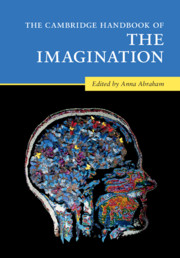Book contents
- The Cambridge Handbook of the Imagination
- The Cambridge Handbook of the Imagination
- Copyright page
- Dedication
- Contents
- Figures
- Contributors
- Acknowledgments
- 1 Surveying the Imagination Landscape
- Part I Theoretical Perspectives on the Imagination
- 2 The Evolution of a Human Imagination
- 3 Material Imagination: An Anthropological Perspective
- 4 The Archaeological Imagination
- 5 Philosophical Perspectives on Imagination in the Western Tradition
- 6 Imagination in Classical India: A Short Introduction
- 7 From Prediction to Imagination
- 8 Memory and Imagination: Perspectives on Constructive Episodic Simulation
- 9 Capturing the Imagination
- 10 A Sociocultural Perspective on Imagination
- 11 Artificial Intelligence and Imagination
- Part II Imagery-Based Forms of the Imagination
- Part III Intentionality-Based Forms of the Imagination
- Part IV Novel Combinatorial Forms of the Imagination
- Part V Phenomenology-Based Forms of the Imagination
- Part VI Altered States of the Imagination
- Name Index
- Subject Index
- References
3 - Material Imagination: An Anthropological Perspective
from Part I - Theoretical Perspectives on the Imagination
Published online by Cambridge University Press: 26 May 2020
- The Cambridge Handbook of the Imagination
- The Cambridge Handbook of the Imagination
- Copyright page
- Dedication
- Contents
- Figures
- Contributors
- Acknowledgments
- 1 Surveying the Imagination Landscape
- Part I Theoretical Perspectives on the Imagination
- 2 The Evolution of a Human Imagination
- 3 Material Imagination: An Anthropological Perspective
- 4 The Archaeological Imagination
- 5 Philosophical Perspectives on Imagination in the Western Tradition
- 6 Imagination in Classical India: A Short Introduction
- 7 From Prediction to Imagination
- 8 Memory and Imagination: Perspectives on Constructive Episodic Simulation
- 9 Capturing the Imagination
- 10 A Sociocultural Perspective on Imagination
- 11 Artificial Intelligence and Imagination
- Part II Imagery-Based Forms of the Imagination
- Part III Intentionality-Based Forms of the Imagination
- Part IV Novel Combinatorial Forms of the Imagination
- Part V Phenomenology-Based Forms of the Imagination
- Part VI Altered States of the Imagination
- Name Index
- Subject Index
- References
Summary
Imagination is said to know no limits. Paradoxically the study of imagination is full of them. This chapter sets out to overcome some of those limits, adopting an anthropological perspective and rethinking imagination’s place in human life and creativity. We step back from the traditional cognitivist view and we try to underline the material bases and enactive character of imagination, challenging the disembodied, purely representational understanding of what it means to imagine. Building on Material Engagement Theory (MET) and focusing on the links between creativity and imagination, we make the case for material imagination: imagination not as a kind of decontextualized mental processing of internal representations, but as a situated dynamic sculpting of heterogeneous resources and processes (both internal and external). In this way the real and the imaginary no longer need to be split apart. Instead, their coming together forms the basis for the endless varieties of human creative gesture. We illustrate that with a simple line; a line imagined out of clay.
Keywords
- Type
- Chapter
- Information
- The Cambridge Handbook of the Imagination , pp. 30 - 46Publisher: Cambridge University PressPrint publication year: 2020
References
- 15
- Cited by



